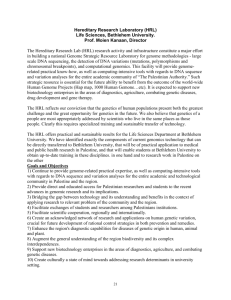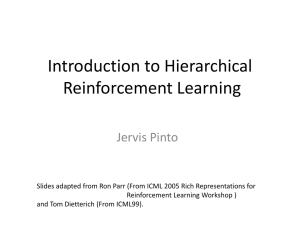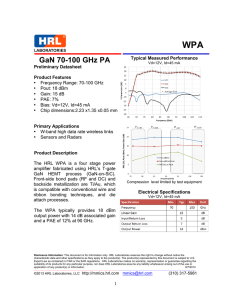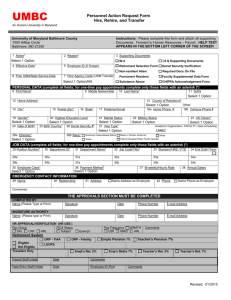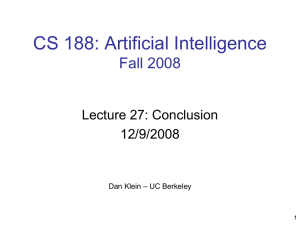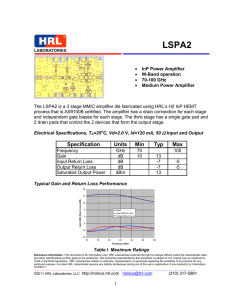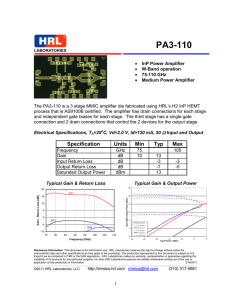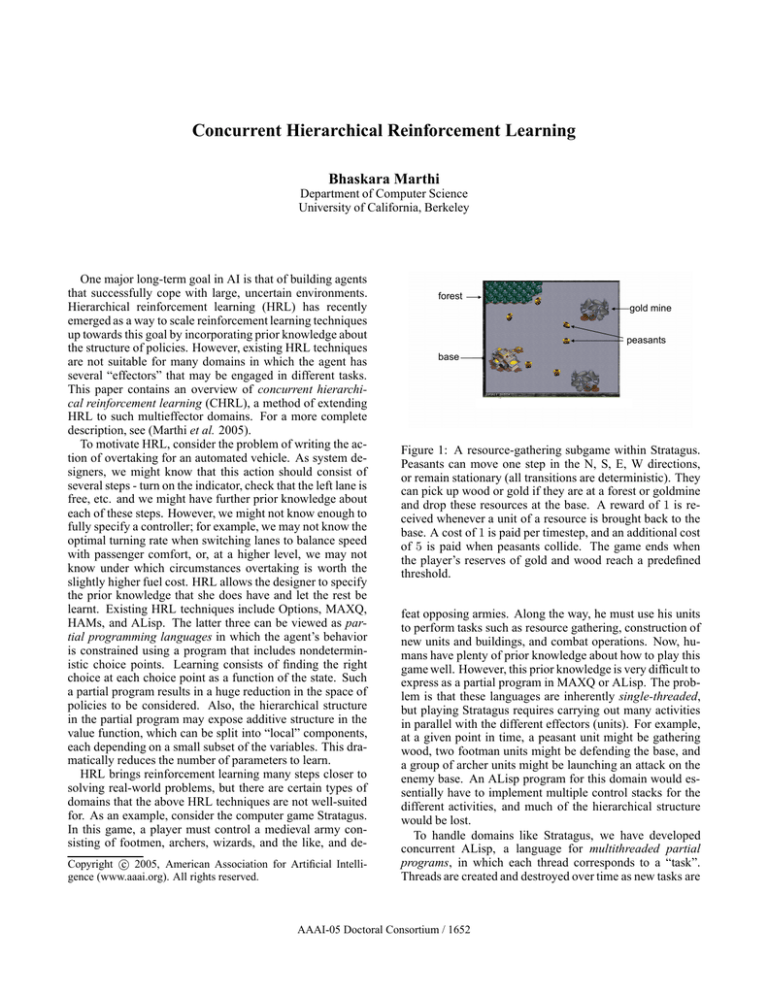
Concurrent Hierarchical Reinforcement Learning
Bhaskara Marthi
Department of Computer Science
University of California, Berkeley
One major long-term goal in AI is that of building agents
that successfully cope with large, uncertain environments.
Hierarchical reinforcement learning (HRL) has recently
emerged as a way to scale reinforcement learning techniques
up towards this goal by incorporating prior knowledge about
the structure of policies. However, existing HRL techniques
are not suitable for many domains in which the agent has
several “effectors” that may be engaged in different tasks.
This paper contains an overview of concurrent hierarchical reinforcement learning (CHRL), a method of extending
HRL to such multieffector domains. For a more complete
description, see (Marthi et al. 2005).
To motivate HRL, consider the problem of writing the action of overtaking for an automated vehicle. As system designers, we might know that this action should consist of
several steps - turn on the indicator, check that the left lane is
free, etc. and we might have further prior knowledge about
each of these steps. However, we might not know enough to
fully specify a controller; for example, we may not know the
optimal turning rate when switching lanes to balance speed
with passenger comfort, or, at a higher level, we may not
know under which circumstances overtaking is worth the
slightly higher fuel cost. HRL allows the designer to specify
the prior knowledge that she does have and let the rest be
learnt. Existing HRL techniques include Options, MAXQ,
HAMs, and ALisp. The latter three can be viewed as partial programming languages in which the agent’s behavior
is constrained using a program that includes nondeterministic choice points. Learning consists of finding the right
choice at each choice point as a function of the state. Such
a partial program results in a huge reduction in the space of
policies to be considered. Also, the hierarchical structure
in the partial program may expose additive structure in the
value function, which can be split into “local” components,
each depending on a small subset of the variables. This dramatically reduces the number of parameters to learn.
HRL brings reinforcement learning many steps closer to
solving real-world problems, but there are certain types of
domains that the above HRL techniques are not well-suited
for. As an example, consider the computer game Stratagus.
In this game, a player must control a medieval army consisting of footmen, archers, wizards, and the like, and dec 2005, American Association for Artificial IntelliCopyright gence (www.aaai.org). All rights reserved.
forest
gold mine
peasants
base
Figure 1: A resource-gathering subgame within Stratagus.
Peasants can move one step in the N, S, E, W directions,
or remain stationary (all transitions are deterministic). They
can pick up wood or gold if they are at a forest or goldmine
and drop these resources at the base. A reward of 1 is received whenever a unit of a resource is brought back to the
base. A cost of 1 is paid per timestep, and an additional cost
of 5 is paid when peasants collide. The game ends when
the player’s reserves of gold and wood reach a predefined
threshold.
feat opposing armies. Along the way, he must use his units
to perform tasks such as resource gathering, construction of
new units and buildings, and combat operations. Now, humans have plenty of prior knowledge about how to play this
game well. However, this prior knowledge is very difficult to
express as a partial program in MAXQ or ALisp. The problem is that these languages are inherently single-threaded,
but playing Stratagus requires carrying out many activities
in parallel with the different effectors (units). For example,
at a given point in time, a peasant unit might be gathering
wood, two footman units might be defending the base, and
a group of archer units might be launching an attack on the
enemy base. An ALisp program for this domain would essentially have to implement multiple control stacks for the
different activities, and much of the hierarchical structure
would be lost.
To handle domains like Stratagus, we have developed
concurrent ALisp, a language for multithreaded partial
programs, in which each thread corresponds to a “task”.
Threads are created and destroyed over time as new tasks are
AAAI-05 Doctoral Consortium / 1652
(defun multi-peasant-top ()
(setf tasks (list #’get-gold #’get-wood))
(loop do
(loop until (my-effectors) do
(choose ’()))
(setf p (first (my-effectors)))
(spawn p (choose tasks) () (list p))))
(defun get-wood ()
(call nav (choose *forest-list*))
(action ’get-wood)
(call nav *home-base-loc*)
(action ’dropoff))
(defun get-gold ()
(call nav (choose *goldmine-list*))
(action ’get-gold)
(call nav *home-base-loc*)
(action ’dropoff))
threads or subroutines. However, experience in the singlethreaded case shows that such decomposition can lead to improved state abstraction and faster learning. We have developed one such decomposed learning algorithm for the case
where there is a fixed set of threads and the reward signal
decomposes across these threads. We are also work towards
scaling up to larger domains. The ultimate goal is to be able
to learn to play the entire Stratagus game. We also plan to
explore other promising applications of CHRL, such as air
traffic management.
References
Marthi, B.; Latham, D.; Russell, S.; and Guestrin, C. 2005.
Concurrent hierarchical reinforcement learning. In IJCAI.
to appear.
(defun nav (l)
(loop until (at-pos l) do
(action (choose ’(N S E W Rest)))))
Figure 2: ALisp program for Resource domain
initiated and terminated. At any point, each effector is assigned to some thread, but this assignment may change over
time. Prior knowledge about coordination between threads
may be included in the partial program, but even if it is not,
threads will coordinate their choices at runtime to maximize
a joint Q-function. The semantics of a concurrent ALisp
program running in an environment can be formalized using
a semi-Markov decision process.
Some of the learning algorithms for single-threaded HRL
can be extended to CHRL. New algorithmic issues arise in
the multi-threaded case, because if multiple threads are making a joint decision, the number of possible choices is exponential in the number of threads. We have adapted the
technique of coordination graphs to the hierarchical setting.
This allows efficient learning and execution in most cases.
As an example, consider the Resource domain in Figure 1. Our prior knowledge for this domain might be that
each peasant should pick a resource type, then pick a location from which to gather the resource resource, navigate to
that location, gather the resource, and return to the base and
drop it off. The partial program in Figure 2 expresses this
knowledge. The program has left certain things unspecified.
For example, it does not say how to allocate peasants to the
different forests and mines, or how to navigate through the
map. Our Q-learning algorithm will “fill in” this knowledge
based on experience.
We have implemented our algorithms, and tested them out
on various subdomains of Stratagus. The algorithms learn
successfully on problems that would be too large for conventional RL techniques and the learnt policies demonstrate
interesting coordinated behaviors.
One important direction for further work is learning.
Our current learning algorithms are not decomposed across
AAAI-05 Doctoral Consortium / 1653

